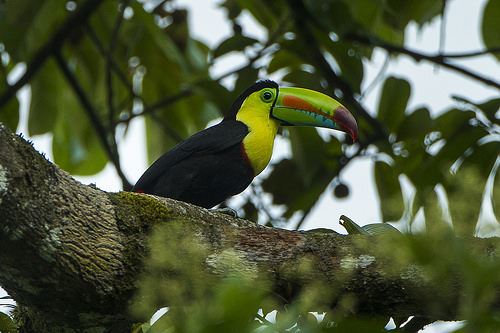The keel-billed toucan is the rainbow of the rainforest.
- Keel-billed toucans are a species of colourful bird, native to southern Mexico, Central America, and northern Venezuela and Columbia.
- ‘Keel-billed toucans’ are also known as ‘rainbow-billed toucans’ and ‘sulfur-breasted toucans’.
- The scientific name of the keel-billed toucan is Ramphastos sulfuratus and it is from the family Ramphastidae, the family of toucans.
- Keel-billed toucans are sizable birds that grow to be about 42 to 55 centimetres (16.5 to 21.6 inches) in height and have wings spanning a width of 109 to 152 centimetres (43 to 60 inches).
- The feather colour of keel-billed toucans is predominantly black, with a striking yellow chest; while the lightweight, multi-coloured, keratin bill is mostly green with a mix of red, orange, and blue.
A Keel-billed Toucan
Image courtesy of Franceso Veronesi/Flickr
- Although the keel-billed toucan itself is not under threat, their numbers are believed to be decreasing due to habitat loss and poaching for its feathers, bill and meat; and it is on a watch-list due to its similar appearance to that of a threatened toucan species.
- Keel-billed toucans live in groups (flocks) of around six to twelve birds, and they snuggle together at night in a hole of tree trunk, while maximising space by tucking their feathers and beak in.
- A keel-billed toucan’s diet consists mostly of fruit; however it also eats eggs and lizards, frogs, insects and young birds to obtain protein.
- Keel-billed toucans are not very adept at flight; rather, they prefer to hop from branch to branch to move.
- Female keel-billed toucans generally lay between 2 to 4 eggs in a hole in a tree, two to three times in a year; and the birds have an average lifespan of 15 to 20 years.
Bibliography:
Carney M, Ramphastos sulfuratus, 2001, Animal Diversity Web, http://animaldiversity.org/accounts/Ramphastos_sulfuratus/
Keel-billed Toucan, 2016, Wikipedia, https://en.wikipedia.org/wiki/Keel-billed_toucan
Keel Billed Toucan, 2016, A-Z Animals, http://a-z-animals.com/animals/keel-billed-toucan/







